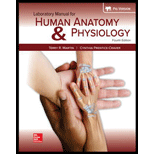
Laboratory Manual For Human Anatomy & Physiology
4th Edition
ISBN: 9781260159363
Author: Martin, Terry R., Prentice-craver, Cynthia
Publisher: McGraw-Hill Publishing Co.
expand_more
expand_more
format_list_bulleted
Question
Chapter 40, Problem 5PL
Summary Introduction
Introduction:
Usually, the  diabetes mellitus has a gradual onset that is diagnosed in individuals above age
diabetes mellitus has a gradual onset that is diagnosed in individuals above age  This disease arises due to the less sensitivity of cells towards the insulin hormone or the lack of insulin receptors. Therefore, the cells become unable to respond to insulin even though the insulin level is normal in the blood.
This disease arises due to the less sensitivity of cells towards the insulin hormone or the lack of insulin receptors. Therefore, the cells become unable to respond to insulin even though the insulin level is normal in the blood.
Expert Solution & Answer
Want to see the full answer?
Check out a sample textbook solution
Students have asked these similar questions
Based on your results from the Mannitol Salt Agar (MSA) media, which of your bacteria were mannitol fermenters and which were not mannitol fermenters?
help tutor please
Q8. A researcher wants to study the effectiveness of a pill intended to reduce stomach heartburn in pregnant
women. The researcher chooses randomly 400 women to participate in this experiment for 9 months of their
pregnancy period. They all need to have the same diet. The researcher designs two groups of 200 participants:
One group take the real medication intended to reduce heartburn, while the other group take placebo
medication. In this study what are:
Independent variable:
Dependent variable:
Control variable:
Experimental group: "
Control group:
If the participants do not know who is consuming the real pills and who is consuming the sugar pills.
This study is
It happens that 40% of the participants do not find the treatment helpful and drop out after 6 months.
The researcher throws out the data from subjects that drop out. What type of bias is there in this study?
If the company who makes the medication funds this research, what type of bias might exist in this
research work?
Chapter 40 Solutions
Laboratory Manual For Human Anatomy & Physiology
Ch. 40 - The _________ cells of pancreatic islets produce...Ch. 40 - Prob. 2PLCh. 40 - Most of the insulin-secreting ceils of a pancreas...Ch. 40 - Prob. 4PLCh. 40 - Prob. 5PLCh. 40 - Type 1 diabetes mellitus occurs in more people...Ch. 40 - Complete the missing parts of table on diabetes...Ch. 40 - Record yow observations of normal behavior of the...Ch. 40 - Match the pancreatic islet hormone in column A to...Ch. 40 - The circles below represent the microscopic field...
Knowledge Booster
Similar questions
- What is behavioral adaptarrow_forward22. Which of the following mutant proteins is expected to have a dominant negative effect when over- expressed in normal cells? a. mutant PI3-kinase that lacks the SH2 domain but retains the kinase function b. mutant Grb2 protein that cannot bind to RTK c. mutant RTK that lacks the extracellular domain d. mutant PDK that has the PH domain but lost the kinase function e. all of the abovearrow_forwardWhat is the label ?arrow_forward
- Can you described the image? Can you explain the question as well their answer and how to get to an answer to an problem like this?arrow_forwardglg 112 mid unit assignment Identifying melting processesarrow_forwardGive only the mode of inheritance consistent with all three pedigrees and only two reasons that support this, nothing more, (it shouldn't take too long)arrow_forward
- Oarrow_forwardDescribe the principle of homeostasis.arrow_forwardExplain how the hormones of the glands listed below travel around the body to target organs and tissues : Pituitary gland Hypothalamus Thyroid Parathyroid Adrenal Pineal Pancreas(islets of langerhans) Gonads (testes and ovaries) Placentaarrow_forward
arrow_back_ios
SEE MORE QUESTIONS
arrow_forward_ios
Recommended textbooks for you
- Essentials of Pharmacology for Health ProfessionsNursingISBN:9781305441620Author:WOODROWPublisher:Cengage





Essentials of Pharmacology for Health Professions
Nursing
ISBN:9781305441620
Author:WOODROW
Publisher:Cengage
